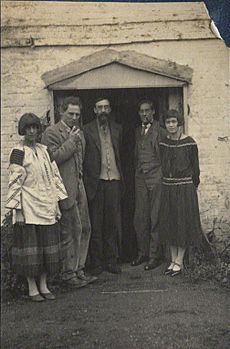Dora Carrington facts for kids
Quick facts for kids
Dora Carrington
|
|
|---|---|
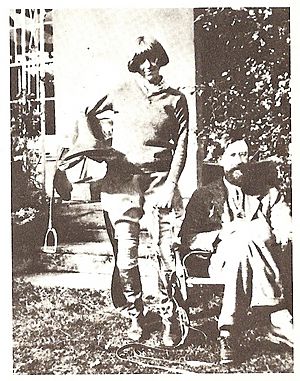
Carrington with Lytton Strachey
|
|
| Born |
Dora de Houghton Carrington
29 March 1893 Hereford, England
|
| Died | 11 March 1932 (aged 38) Newbury, Berkshire, England
|
| Education | Slade School of Art, University College London |
Dora de Houghton Carrington (born March 29, 1893 – died March 11, 1932) was an English painter. She was also a decorative artist. People often knew her simply as Carrington. She was famous for her connection to the Bloomsbury Group. This was a group of writers and artists. She was especially close to the writer Lytton Strachey.
From her student days, she preferred to be called just Carrington. She thought the name Dora sounded "vulgar and sentimental." During her life, she was not very well-known as a painter. This was because she rarely showed her art. She also did not sign her paintings. Carrington worked for the Omega Workshops. She also designed woodcuts for the Hogarth Press.
Contents
Early Life and Art School
Carrington was born in Hereford, England. Her father, Samuel Carrington, was a railway engineer. Her mother was Charlotte Houghton. Dora was the fourth of their five children.
She went to Bedford High School. This was an all-girls' school that focused on art. Her parents paid for her to have extra drawing lessons. She won many awards in national art competitions. These were run by the Royal Drawing Society.
In 1910, Carrington went to the Slade School of Art in London. She won a scholarship there. She also earned several other prizes. Her classmates included Paul Nash and Mark Gertler.
In 1912, Carrington learned about fresco painting. Frescoes are paintings made on wet plaster. The next year, she painted three large frescoes. She worked with Constance Lane for a library at Ashridge. After art school, Carrington lived in London. She had a studio in Chelsea. Her paintings were shown in some group exhibitions. She decided to stop signing and dating her work. In 1914, her parents moved to a village in Hampshire. Carrington soon moved there too. She set up her art studio in an outbuilding.
Artistic Career and Friendships
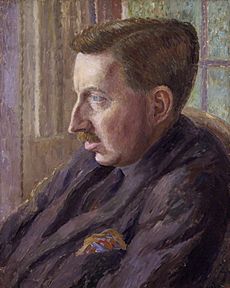
Carrington was not officially part of the Bloomsbury Group. However, she was very close to them. She was especially close to the writer Lytton Strachey. They first met in 1916. She also had a close friendship with the writer Gerald Brenan.
In 1918, the writer Virginia Woolf described Carrington. She wrote that Carrington was "eager to please" and "restless." Woolf also said she was "such a bustling eager creature." Carrington moved in with Lytton Strachey in November 1917. They lived together at Tidmarsh Mill House.
Carrington met Ralph Partridge in 1918. He was a friend of her younger brother. In 1921, Carrington agreed to marry Ralph. Strachey paid for their wedding. He even went with them on their honeymoon. In 1924, the three of them moved to Ham Spray House. Strachey bought this house.
In 1926, Ralph Partridge moved to London. He still visited Carrington most weekends. In 1928, Carrington met Bernard Penrose. She began a close friendship with him. This friendship made Carrington feel more creative. She also worked with Penrose on three films.
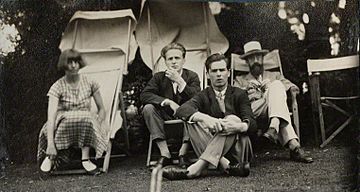
During her life, Carrington's art did not get much attention. This lack of encouragement might have stopped her from showing her work. Her art was unique for its time in England. It often featured Victorian-style pictures. These were made from colored tinfoil and paper.
Carrington often drew sketches in letters to her friends. She wanted to entertain them. She also made woodblock prints, which were highly praised. Her other works included painted pub signs and murals. She also decorated ceramics, fireplaces, and tin trunks.
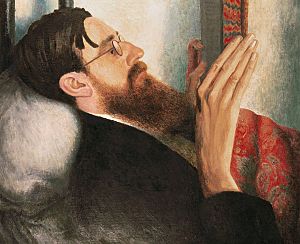
Carrington was also known for her landscape paintings. These paintings sometimes had a dream-like quality. Her landscapes mixed real views with her own feelings. One painting, Mountain Ranges from Yegen, Andalusia (1924), shows this mix. It has a close-up view in the front. Then, in the distance, are the mountains. The middle mountains look like human skin. This shows how personal feelings can appear in public art.
Her Bond with Lytton Strachey
For many years, people did not pay much attention to Carrington's art. She was mostly known for her close bond with Lytton Strachey. The day she agreed to marry Ralph Partridge, she wrote to Strachey. He was in Italy at the time. She wrote about her deep feelings for him.
Strachey wrote back to her. He said he loved her "as something more than a friend." He also said her presence in his life was "one of the most important things." On his deathbed, Strachey said he had always wanted to marry Carrington. This showed how much he cared for her. When he died, Strachey left Carrington a large sum of money.
Later Life and Passing
Carrington passed away on March 11, 1932. Her body was cremated. Her ashes were buried in the garden of Ham Spray House.
Her Artistic Legacy
Carrington was a talented painter of portraits and landscapes. She also worked in applied arts. This means she painted on many surfaces. She painted on inn signs, tiles, and furniture. She also decorated pottery. She designed the library at Ham Spray House.
In 1970, David Garnett published some of her letters and diary entries. After this, people started to appreciate her work much more. In 1978, Sir John Rothenstein called Dora Carrington "the most neglected serious painter of her time." He was the director of the Tate Gallery in London.
Carrington was one of five artists in a TV series. It was called Five Women Painters in 1989. In 1995, a big exhibition of her work was held. It was at the Barbican Art Gallery in London. Two of her paintings are now in the Tate Gallery.
See also
 In Spanish: Dora Carrington para niños
In Spanish: Dora Carrington para niños


